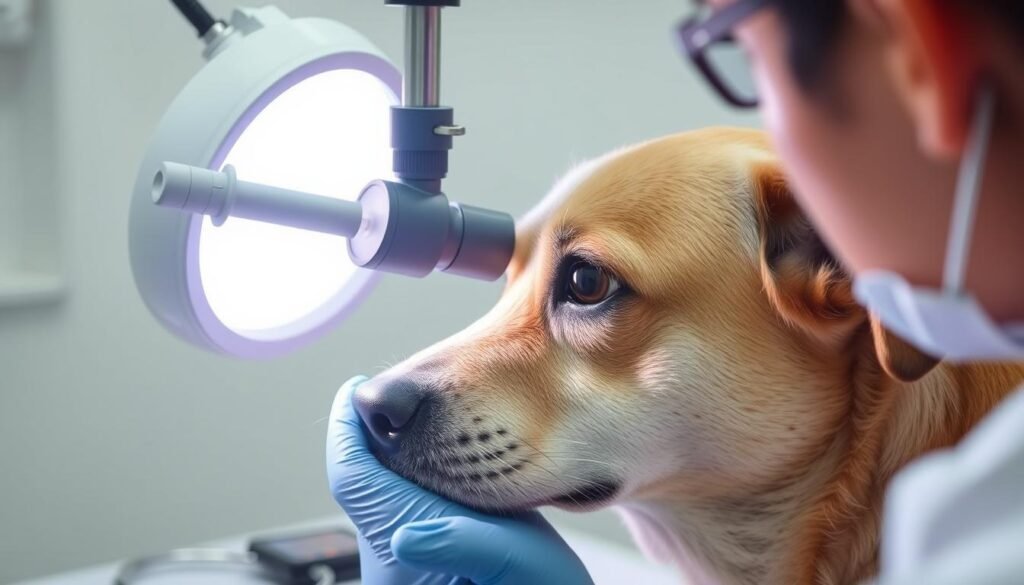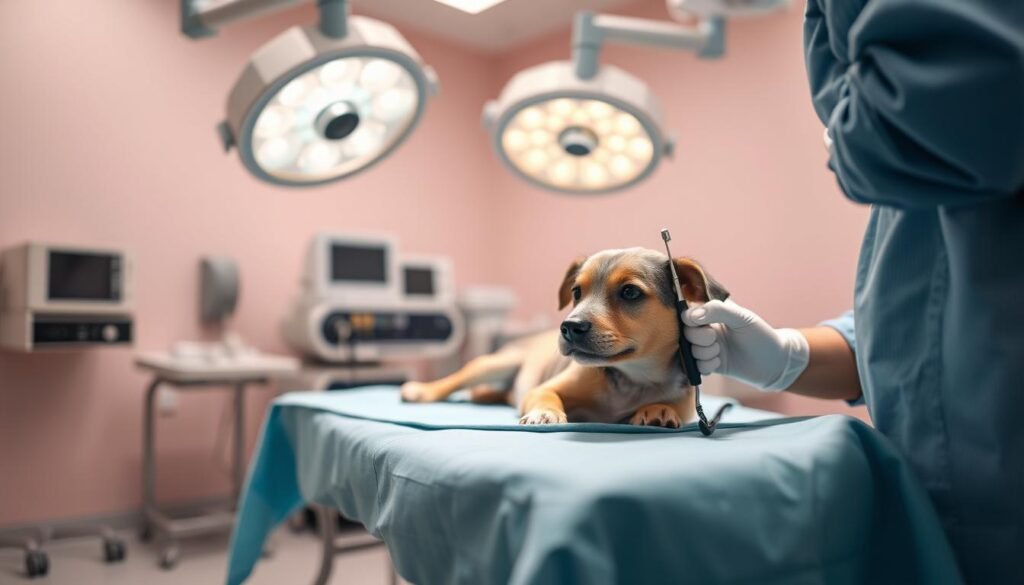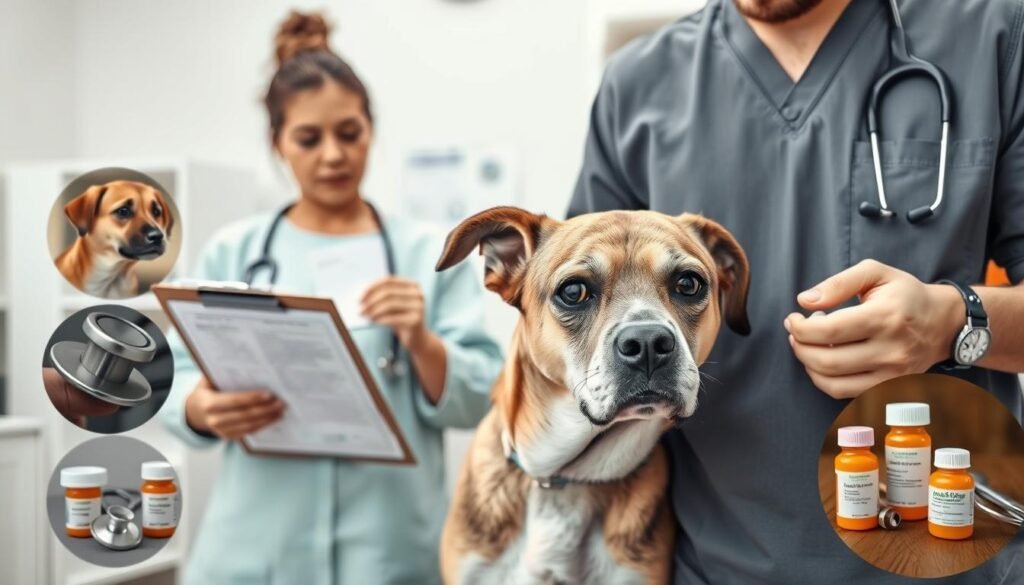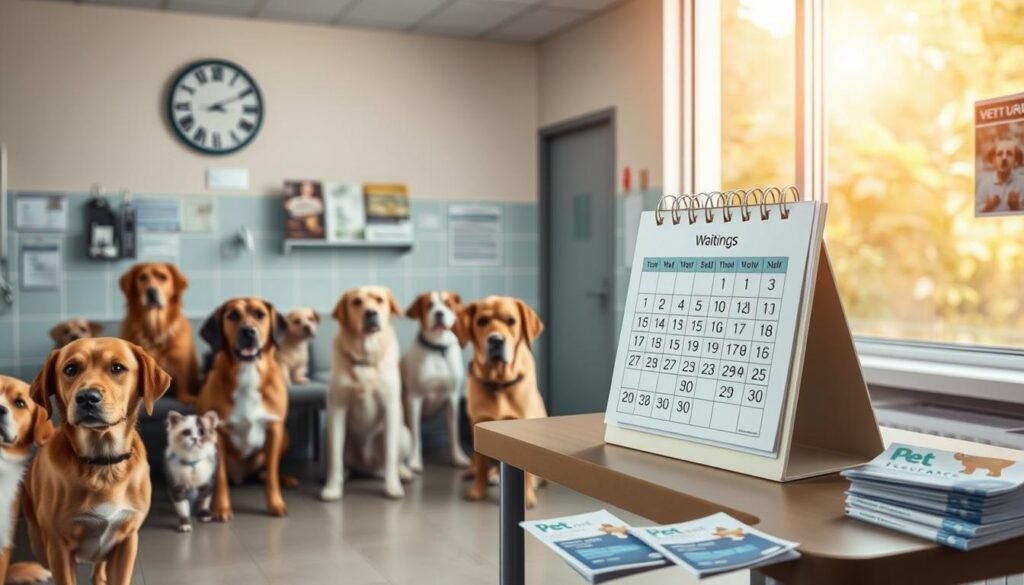Did you know that 85% to 90% of dogs do well after cataract surgery1? Losing your pet’s vision is scary. Cataracts, common in older pets, can cause blindness if not treated2. But, many pet insurance plans cover cataract surgery, as long as it’s not pre-existing and the waiting period is over2.
Key Takeaways
- Most pet insurance policies cover cataract treatment, as long as it’s not a pre-existing condition and the waiting period has passed.
- Cataracts can lead to vision impairment and even complete blindness in pets if left untreated.
- Cataract surgery has a high success rate, with 85% to 90% of dogs experiencing long-term vision improvement.
- The average cost of cataract surgery in dogs ranges from $2,700 to $4,000 per eye.
- Pet insurance typically reimburses around 80% of covered veterinary costs after the deductible is met.
Understanding Cataracts in Pets
Cataracts are a common eye problem in pets, like dogs and cats. This condition makes the lens cloudy, causing vision issues and sometimes blindness3. Knowing about cataracts helps pet owners give their pets the best care and treatment.
What are Cataracts?
Cataracts make the eye lens cloudy, leading to vision problems. They can happen in dogs, cats, and other animals. The severity can range from mild to complete blindness4. Pets with cataracts may see blurry, struggle in dim light, or even lose their sight if not treated.
What Causes Cataracts?
Most cataracts in pets come from aging5. But, other things like genetics, diabetes, eye trauma, or toxins can also cause them5. Some dog breeds, like Boston Terriers and Golden Retrievers, are more likely to get cataracts3.
| Cause of Cataracts in Pets | Prevalence |
|---|---|
| Age-related degeneration | Most common |
| Genetic predisposition | Certain breeds are more prone |
| Medical conditions (e.g., diabetes, hypothyroidism) | Significant risk factor |
| Trauma to the eye | Less common but possible |
| Exposure to medications or toxins | Rare but can occur |
“Cataracts are not preventable in dogs, but efforts to stabilize conditions like diabetes and mitigate risk factors in predisposed breeds can help manage the development of cataracts.”5
Signs and Symptoms of Cataracts in Pets
As your pet gets older, watch for signs of cataracts. These cloudy formations can hurt your pet’s vision, even leading to blindness if not treated6. Some dog breeds, like Afghan Hounds and Golden Retrievers, are more likely to get cataracts6.
Common symptoms include:
- Blurred vision
- Difficulty seeing in low light
- Increased clumsiness
- Squinting or rubbing the eyes
- A milky or cloudy eye appearance
If you see these signs of cataracts in pets or symptoms of cataracts in pets, see a vet7. Dogs and cats can get cataracts, and it’s more common in older pets7. Early treatment can prevent more vision loss and discomfort.
By being alert and knowing how to tell if my pet has cataracts, you can help your pet’s eye health. Getting vet care early can greatly help manage this common issue678.
How are Cataracts Diagnosed in Pets?
Diagnosing cataracts in pets is key to treating them right and keeping them happy. Vets use a detailed eye check to spot and check the condition. This check might include looking closely, measuring eye pressure, and checking the lens’s clarity9.
If cataracts are found, your vet will talk about treatment options. They’ll help you choose the best way to care for your pet10.
Some dog breeds, like Cocker Spaniels and Poodles, are more likely to get cataracts11. Older dogs and those with diabetes are also at higher risk11.
Cataracts can get worse over time, from early to very advanced11. It’s important to keep up with your vet to watch the condition and plan the best action.
“Proper diagnosis and early intervention are key to managing cataracts in pets and preserving their vision and quality of life.”

There’s no home remedy to stop cataracts in dogs from getting worse11. In serious cases, surgery like removing the eye might be needed11.
By teaming up with your vet and acting fast on cataract signs, you can keep your pet’s vision and health top-notch.
Does Pet Insurance Cover Cataract Surgery
Pet insurance can be a big help when it comes to cataract treatment costs for our pets. If the cataracts aren’t a pre-existing condition and the waiting period is over, most pet insurance policies can help. They can cover the costs of surgery needed to treat cataracts12.
Cataract surgery for dogs can cost between $2,700 and $4,000. This cost depends on location, pre-surgery care, each eye’s condition, and post-surgery care and meds12. So, pet parents can worry less about the high costs of care.
It’s key for pet parents to check their insurance policy to see if cataract treatment is covered. This way, they can act fast and prevent more vision loss and discomfort for their pets13. Pet insurance for surgery covers many things, like anesthesia, vet & tech time, and follow-up care13. With an 80% reimbursement rate, a $3,000 surgery could leave you with just $600 to pay12.
Pet insurance can be a lifesaver when it comes to covering the eligible costs of cataract treatment for our furry friends.
The Treatment of Cataracts in Pets
Cataracts in pets can be treated with surgery. The most common method is phacoemulsification, where ultrasound breaks down the cloudy lens14. After removal, an artificial lens is put in to help the pet see clearly. This surgery is done by a vet specialist and can cost between $2,000 to $5,00014.
How Cataract Surgery Works for Dogs
The success rate for cataract surgery in dogs is high, at 85% to 90%14. The surgery involves removing the cloudy lens and replacing it with an artificial one15. It’s usually done on dogs over 8 years old, as they are more likely to get cataracts15.
The Average Cost of Dog Cataract Surgery
The cost of cataract surgery for pets can be between $2,000 and $5,00014. Single-eye surgery costs $2,000 to $3,000, and both eyes surgery costs $3,500 to $4,50014. Some pet insurance plans may cover 70%, 80%, or 90% of the cost14. But, pets with pre-existing conditions like cataracts might not be covered14.

Insurance providers like Trupanion, Lemonade, MetLife, and Spot offer coverage for cataract surgery14. Monthly premiums start around $59, $10, $9, and are customizable14. MetLife covers up to 80% of surgery costs, and Lemonade offers 80% reimbursement14.
“The prognosis for cataract surgery in dogs typically results in a 95% vision rate.”15
Pre-existing Conditions and Pet Insurance
Pre-existing conditions are key when choosing pet insurance. They include any health issues your pet had before you got the insurance. It’s important to know about these conditions to pick the right insurance for your pet.
Most pet insurance plans don’t cover pre-existing conditions16. This means they won’t pay for treatments for these conditions16. But, some plans might cover certain conditions or pre-existing conditions if your pet is healthy for a while, like 180 days16.
Insurance companies often don’t cover chronic conditions like arthritis or diabetes17. They also might not cover conditions like heart problems or cancer if they were there before you got the insurance17. Conditions like respiratory infections or cancer within a year of diagnosis are also often not covered17.
| Condition | Coverage Likelihood |
|---|---|
| Curable pre-existing conditions | May be covered if pet has been symptom-free for a specific period (e.g., 180 days) |
| Incurable pre-existing conditions | Usually not covered by pet insurance |
| Bilateral conditions (e.g., hip dysplasia, cataracts) | Often not covered if diagnosed before enrollment |
When you apply for pet insurance, the company will check your pet’s health records16. It’s wise to get insurance, even with pre-existing conditions, to cover future health issues16.

Knowing about pre-existing conditions helps you choose the right insurance for your pet1716.
Waiting Periods for Pet Insurance Coverage
Pet insurance has waiting periods. These are times when you can’t use the insurance right away18. If your pet gets sick or hurt during this time, you might have to pay for treatment yourself. The length of these waiting periods varies by insurance company and what you’re covered for.
Understanding Waiting Periods
Insurance plans have different waiting times for different needs. For example, accidents might have a 2-day wait, while illnesses have a 14-day wait18. Orthopedic issues might wait 30 days, and cruciate ligament problems could wait 6 months18. Always check your policy to know the exact waiting times for your coverage.
Also, you need at least 12 and a half months of your pet’s medical history to qualify18. This helps the insurance company understand your pet’s health and any conditions they might not cover.
Waiting periods start from when you first get the policy18. You must have the policy active for the full waiting period before you can get reimbursed18. Switching insurance might make you start over with waiting periods, depending on the new company’s rules18.
To get the most out of your pet insurance, know about waiting periods18. Plan ahead to make sure your pet gets the care they need quickly18. Understanding these periods helps you use your insurance wisely.

| Type of Coverage | Waiting Period |
|---|---|
| Accidents | 2 days |
| Illnesses | 14 days |
| Orthopedic Conditions | 30 days |
| Cruciate Ligament Events | 6 months |
| Medical Records Required | 12.5 months |
The policy starts at 12:01 AM the day after you buy it18. So, waiting periods start right away, and you can’t use the insurance until they’re over1819.
Conclusion
Cataracts can greatly affect our pets’ vision and overall health20. They can make pets uncomfortable, leading to changes in behavior and vision problems20. It’s important to catch and treat cataracts early to prevent more vision loss and discomfort.
Pet insurance that covers pet insurance for cataract surgery can help a lot20. The cost of surgery is about $200020. With a monthly premium of around $50, insurance can make treatment more affordable20.
This way, pet owners can give their pets the care they need without worrying about the cost20. It also brings peace of mind, knowing they’re ready for any treatment20. Whether or not to have surgery depends on the vet’s evaluation of the pet’s vision and health20. Also, it’s key to check if is cataract surgery covered by pet insurance because insurance usually doesn’t cover routine care or elective procedures20.
FAQ
Can pet insurance cover cataract surgery?
Can you cancel pet insurance at any time?
Does pet insurance have a cancellation policy?
How do I terminate my pet’s insurance coverage?
Can I stop paying for my pet’s insurance?
How do I withdraw from my pet’s insurance plan?
Can I opt-out of my pet’s insurance coverage?
How do I quit my pet insurance contract?
Can I drop my pet’s insurance plan?
Can I cancel my pet insurance mid-term?
Source Links
- Dog Cataract Surgery Costs and How to Save – https://www.pawlicy.com/blog/dog-cataract-surgery-cost/
- Does Pet Insurance Cover Cataracts? Who Can Get Coverage? | Spot® – https://spotpet.com/blog/why-pet-insurance/does-pet-insurance-cover-cataracts
- How Much Does Dog Cataract Surgery Cost? 2024 Guide – https://www.lemonade.com/pet/explained/dog-cataract-surgery-cost/
- Dog Cataract Surgery: Cost, Vet Review | MetLife Pet Insurance – https://www.metlifepetinsurance.com/blog/pet-health/dog-cataract-surgery/
- How Much Does Cataract Surgery For Dogs Cost? (2024 Guide) – https://www.forbes.com/advisor/pet-insurance/pet-care/cataract-surgery-cost-dogs/
- Cataracts in Dogs and Cats | Symptoms & Treatment – https://www.embracepetinsurance.com/health/cataracts
- Dog Cataract Surgery Cost 2024 – https://www.insuranceopedia.com/pet-insurance/dog-cataract-surgery-cost
- Common Illness in Dogs – Cataracts | Healthy Paws Pet Insurance – https://www.healthypawspetinsurance.com/blog/dog-cataracts
- Tiny Mixed-Breed Dog Beats Cataracts to Regain Sight | Healthy Paws Pet Insurance – https://www.healthypawspetinsurance.com/blog/tiny-mixed-breed-dog-beats-cataracts-to-regain-sight
- How Much Does Dog Cataract Surgery Cost? – https://insuranceranked.com/pet-insurance/how-much-does-dog-cataract-surgery-cost
- Cataracts in Dogs | A Complete Guide | Odie Pet Insurance – https://getodie.com/blog/cataracts-in-dogs-get-rid-of-it-once-and-for-all/
- Dog Cataract Surgery Cost (2024 Guide) – https://www.marketwatch.com/guides/pet-insurance/dog-cataract-surgery-cost/
- Surgery Coverage | Embrace Pet Insurance – https://www.embracepetinsurance.com/coverage/surgery-coverage
- Does Pet Insurance Cover Cataract Surgery? – Pet Insurance Review – https://www.petinsurancereview.com/blog/does-pet-insurance-cover-cataract-surgery
- Cataracts in dogs and cats – https://bowwowinsurance.com.au/pet-care/diseases-conditions/cataracts-in-dogs-and-cats/
- Does Pet Insurance Cover Pre-Existing Conditions? – https://www.petmd.com/general-health/does-pet-insurance-cover-pre-existing-conditions
- No title found – https://www.akc.org/expert-advice/health/pre-existing-condition-world-pet-insurance/
- Waiting Periods – https://www.lemonade.com/pet/explained/waiting-periods/
- Does Pet Insurance Cover Surgery? – https://money.com/does-pet-insurance-cover-surgery/
- Pet Insurance & Cataract Surgery: Facts, Coverage, Cost & FAQ – Dogster – https://www.dogster.com/dog-health-care/pet-insurance-and-cataract-surgery
